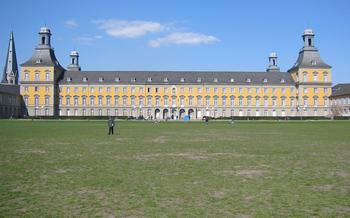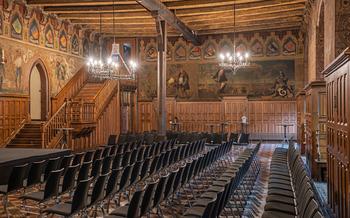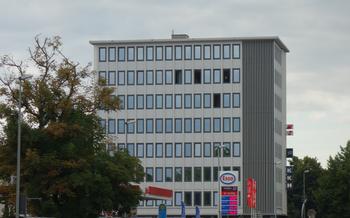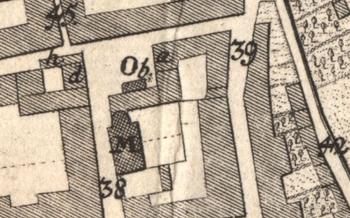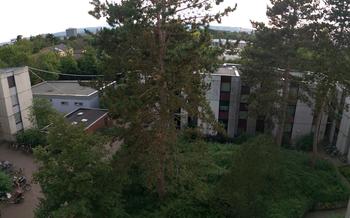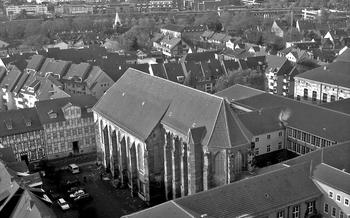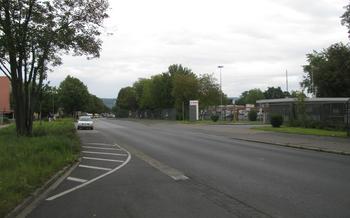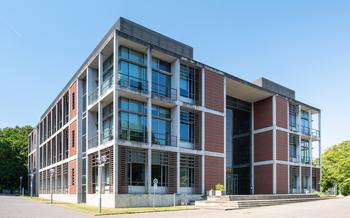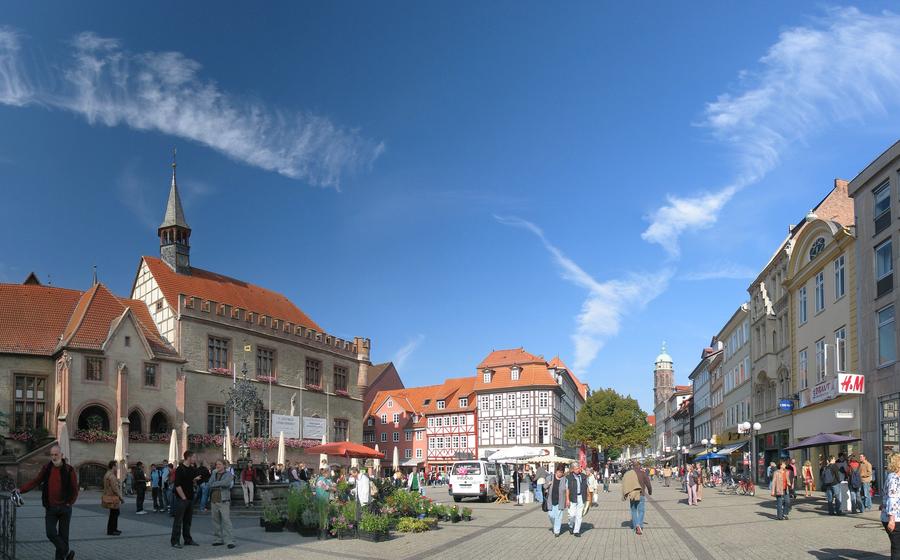
Astronomical Observatory Hainberg
- A Journey to the Stars: Visiting the Astronomical Observatory Hainberg
- Exploring the Cosmos: The Observatory's Telescopes
- Cosmic Wonders Unveiled: Guided Tours and Programs
- A Starry Night Experience: Public Observing Nights
- Unveiling the Mysteries of the Universe: Exhibitions and Displays
- A Glimpse into the Past: The Observatory's History
- A Culinary Adventure: Dining Near the Observatory
- Accommodation Options for Stargazers
- Astronomy for Everyone: Outreach and Education
- A Journey Through Time: The Observatory Museum
- Capturing the Cosmos: Astrophotography at the Observatory
- Exploring the Night Sky: Stargazing Spots Near Göttingen
- Insider Tip: Unveiling Hidden Celestial Treasures
A Journey to the Stars: Visiting the Astronomical Observatory Hainberg
Nestled amidst the picturesque town of Göttingen, Germany, the Astronomical Observatory Hainberg stands as a beacon of scientific exploration and celestial wonders. Established in 1816, the observatory has played a pivotal role in advancing our understanding of the universe, contributing to groundbreaking discoveries and shaping the course of astronomy.
Perched atop the Hainberg hill, the observatory offers a breathtaking panorama of the surrounding landscape, making it a popular destination for both amateur astronomers and seasoned stargazers. The observatory houses a collection of state-of-the-art telescopes, granting visitors an unparalleled opportunity to delve into the mysteries of the cosmos, embarking on a journey through the galaxies and beyond.
Whether you're an astronomy enthusiast seeking to unravel the secrets of the universe or simply a curious traveler yearning for a glimpse of the starry expanse, the Astronomical Observatory Hainberg promises an unforgettable experience that will ignite your imagination and leave you with a profound sense of wonder.
To fully immerse yourself in the wonders of the cosmos, plan your visit during clear weather conditions, allowing for optimal viewing. The observatory offers guided tours and public observing nights, providing a unique opportunity to learn about the universe from experienced astronomers and gaze upon the celestial tapestry with your own eyes.
Getting to the observatory is a breeze, whether you opt for the convenience of public transportation or the flexibility of your own vehicle. Public buses run regularly to the observatory, while ample parking is available for those arriving by car.
Exploring the Cosmos: The Observatory's Telescopes
The Astronomical Observatory Hainberg boasts an impressive array of telescopes, each offering unique capabilities for exploring the cosmos. The main telescope, a 1-meter reflector, is one of the largest in Germany and allows astronomers to peer deep into space, capturing stunning images of distant galaxies, nebulae, and star clusters. The observatory also houses a 60-cm refractor, a versatile telescope ideal for observing planets, double stars, and other objects within our solar system. For solar observations, visitors can use the observatory's specialized solar telescope, which provides a safe and detailed view of the Sun's surface, including sunspots, prominences, and flares.
The telescopes at the Hainberg Observatory are equipped with advanced technology, including computerized tracking systems, CCD cameras, and spectrographs. These instruments enable astronomers to collect valuable data, measure the properties of celestial objects, and study the composition and dynamics of stars, galaxies, and nebulae. Visitors to the observatory can learn about the telescopes and their capabilities during guided tours and public observing nights, where astronomers share their knowledge and insights into the wonders of the universe.
One memorable observation made using the observatory's telescopes was the discovery of a new exoplanet orbiting a distant star. The planet, which was imaged using the 1-meter reflector, was found to be a hot Jupiter-like world, orbiting its host star at a very close distance. This discovery highlighted the observatory's role in contributing to cutting-edge research in the field of exoplanetary science.
Cosmic Wonders Unveiled: Guided Tours and Programs
The Astronomical Observatory Hainberg offers a variety of guided tours and programs that provide visitors with an immersive and educational experience. Whether you're a seasoned astronomy enthusiast or simply curious about the wonders of the universe, these guided tours are designed to cater to all levels of knowledge and interest.
Guided Tours:
Join a knowledgeable and passionate astronomer on a guided tour of the observatory's facilities. During the tour, you'll explore the history and significance of the observatory, learn about the different telescopes and instruments used for astronomical observations, and gain insights into the latest astronomical research. Guided tours typically last for about an hour and are available on a regular basis.
Special Programs and Events:
In addition to regular guided tours, the observatory also hosts a variety of special programs and events throughout the year. These events often feature guest speakers, workshops, and hands-on activities that delve deeper into specific astronomical topics. From lectures on the latest discoveries in astrophysics to stargazing parties and meteor shower observations, there's always something exciting happening at the observatory.
Tips for a Fulfilling Guided Tour Experience:
-
Book in Advance: Guided tours are popular, so it's advisable to book your spot in advance, especially if you're visiting during peak tourist season.
-
Arrive Early: Arriving early for your tour will give you ample time to settle in, ask questions, and get a good view of the exhibits before the tour begins.
-
Dress for the Weather: The observatory is located on a hilltop, so the weather can be unpredictable. Be sure to dress in layers and bring a jacket or sweater, even if the weather forecast looks favorable.
-
Bring a Notebook and Pen: Taking notes during the tour can help you retain information and remember the key points discussed.
-
Ask Questions: Don't hesitate to ask questions during the tour. The astronomers leading the tours are experts in their field and are happy to share their knowledge and answer your queries.
A Starry Night Experience: Public Observing Nights
The Astronomical Observatory Hainberg offers public observing nights on a regular basis, providing an opportunity for visitors to experience the wonders of the night sky through the observatory's powerful telescopes. These nights are typically held on clear evenings, and visitors can expect to see a variety of celestial objects, including planets, stars, galaxies, and nebulae.
During a public observing night, visitors will be guided by experienced astronomers who will help them navigate the night sky and identify the various objects visible. Telescopes of different sizes and capabilities will be available for use, allowing visitors to get a closer look at the cosmos. Whether you're a seasoned astronomer or a complete novice, public observing nights at the Hainberg Observatory offer a unique and unforgettable experience for all.
Be sure to dress warmly, as temperatures can drop significantly at night. It's also a good idea to bring a flashlight or headlamp for navigating the observatory grounds, as well as a pair of binoculars or a small telescope if you have one.
One memorable public observing night at the Hainberg Observatory occurred during a meteor shower. Visitors were treated to a spectacular display of shooting stars, with meteors streaking across the sky in all directions. It was a truly awe-inspiring sight that left everyone in attendance with a sense of wonder and amazement.
Unveiling the Mysteries of the Universe: Exhibitions and Displays
The Astronomical Observatory Hainberg in Göttingen offers a range of exhibitions and displays that provide visitors with an immersive experience into the wonders of the cosmos. These exhibits showcase fascinating scientific concepts, astronomical phenomena, and the latest discoveries in the field of astronomy.
One of the highlights of the exhibitions is the "Journey Through the Universe" display, which takes visitors on an awe-inspiring voyage across the vast expanse of space. Interactive exhibits allow visitors to explore the properties of different stars, galaxies, and planets, while stunning visuals and immersive soundscapes create a truly captivating experience.
Another popular exhibit is the "Observing the Sun" display, which provides a glimpse into the dynamic nature of our closest star. Visitors can learn about the sun's structure, its magnetic activity, and the fascinating phenomena of sunspots and solar flares. Interactive exhibits allow visitors to safely observe the sun through special telescopes and explore the impact of solar activity on Earth.
In addition to these permanent exhibits, the observatory also hosts temporary exhibitions on various astronomical topics. These exhibitions often feature the latest research findings, cutting-edge technologies, or historical artifacts related to astronomy. Visitors can stay up-to-date on upcoming exhibitions through the observatory's website or by following their social media channels.
To make the most of your visit to the exhibitions, it's recommended to allocate at least an hour to explore the various displays. Guided tours are also available for a more in-depth understanding of the exhibits and the scientific concepts they represent.
A Glimpse into the Past: The Observatory's History
The Astronomical Observatory Hainberg has a rich and storied history, dating back to its founding in 181It was established by Carl Friedrich Gauss, a renowned mathematician and astronomer, who played a crucial role in the development of the observatory. Under his leadership, the observatory quickly gained prominence and became a center for astronomical research and education.
Throughout the years, the observatory has witnessed numerous significant discoveries and achievements. In 1845, the astronomer Wilhelm Olbers discovered the comet 13P/Olbers, which bears his name. In 1870, the observatory's director, Julius Schmidt, developed the first successful wide-field camera for astronomical photography. This invention revolutionized the field of astrophotography and allowed astronomers to capture stunning images of the night sky.
In the early 20th century, the observatory became a part of the University of Göttingen. This affiliation brought new resources and opportunities, enabling the observatory to expand its research and educational activities. During World War II, the observatory suffered some damage, but it was quickly rebuilt after the war.
Today, the observatory continues to be a vibrant center for astronomical research and outreach. It is home to a team of dedicated astronomers who conduct cutting-edge research using the observatory's telescopes. The observatory also plays an important role in science education, offering guided tours, public observing nights, and educational programs for students of all ages.
A Culinary Adventure: Dining Near the Observatory
A visit to the Astronomical Observatory Hainberg can be complemented by a culinary adventure in Göttingen's vibrant dining scene. Within walking distance of the observatory, visitors can find a diverse range of restaurants and cafes catering to various tastes and budgets.
For those seeking a traditional German dining experience, the Ratskeller, located in the heart of the city, offers a cozy atmosphere and a menu featuring classic dishes such as schnitzel and bratwurst. Alternatively, the Brauhaus Göttingen, a lively brewpub, serves up hearty meals paired with freshly brewed beer.
International cuisine is also well-represented near the observatory. The Olive Tree offers a Mediterranean culinary journey with its flavorful Greek and Italian dishes, while the Maharaja Palace transports diners to India with its aromatic curries and tandoori specialties.
For a quick bite or a sweet treat, visitors can head to the Café am Wall, a cozy spot serving up delicious cakes, pastries, and coffee. The Eiscafé Rialto, with its wide selection of homemade ice cream, is a popular choice for a refreshing treat on a warm summer evening.
When dining in Göttingen, be sure to sample local specialties such as the Göttinger sausage, a unique type of smoked sausage, and the Harzer cheese, a tangy cheese made from cow's milk.
To avoid tourist traps and discover hidden culinary gems, venture off the beaten path and explore the side streets and alleys around the observatory. Here, visitors can find charming local restaurants offering authentic German cuisine and international flavors.
Accommodation Options for Stargazers
When planning your visit to the Astronomical Observatory Hainberg, finding the perfect accommodation is essential to enhance your stargazing experience. Göttingen offers a range of accommodation options to suit every budget and preference, ensuring a comfortable and convenient stay for star enthusiasts.
For those seeking a truly immersive experience, consider booking a room at one of the hotels or guesthouses located near the observatory. These accommodations offer easy access to the observatory, allowing you to maximize your stargazing time. Some accommodations even provide stunning views of the night sky, turning your room into a private observatory.
If you prefer a more budget-friendly option, there are several hostels and guesthouses within walking distance of the observatory. These accommodations offer basic yet comfortable rooms at affordable rates, enabling you to save money without compromising on convenience.
For a unique and memorable experience, consider staying at one of the traditional German guesthouses or bed and breakfasts in the surrounding villages. These accommodations offer a glimpse into local culture and cuisine, providing a charming and authentic touch to your stargazing adventure.
To make the most of your stay, it's advisable to book your accommodation in advance, especially during peak tourist season or special events at the observatory. This will ensure you secure a room with the desired amenities and proximity to the observatory.
Whether you choose a luxurious hotel, a cozy guesthouse, or a budget-friendly hostel, Göttingen offers a variety of accommodation options to cater to the needs of every stargazer. With a comfortable place to rest and recharge, you can fully embrace the wonders of the universe that await you at the Astronomical Observatory Hainberg.
Astronomy for Everyone: Outreach and Education
The Astronomical Observatory Hainberg is committed to sharing the wonders of the cosmos with the broader community. Its outreach programs and educational initiatives aim to inspire a passion for astronomy and cultivate scientific literacy among people of all ages.
The observatory offers a diverse range of workshops, lectures, and astronomy courses tailored to different audiences. Public lectures by renowned astronomers provide insights into cutting-edge research and discoveries, while hands-on workshops introduce participants to the practical aspects of astronomy, such as telescope operation and astrophotography.
To engage younger minds, the observatory organizes educational programs for school groups and families. Interactive exhibits, guided tours, and storytelling sessions bring astronomy to life for children, fostering their curiosity and imagination.
The observatory also collaborates with local schools and universities to develop astronomy-related curricula and projects. Through these initiatives, the observatory plays a vital role in nurturing the next generation of astronomers and space enthusiasts.
Getting involved in astronomy-related activities at the observatory is easy and rewarding. Visitors can sign up for workshops and courses, attend public lectures, or simply drop by during public observing nights. The observatory's friendly and knowledgeable staff is always ready to assist visitors and answer their questions, making astronomy accessible and enjoyable for everyone.
A Journey Through Time: The Observatory Museum
Step into the realm of astronomical history at the Observatory Museum, a treasure trove of artifacts and exhibits that narrate the captivating journey of astronomy and the observatory's significant contributions to the field. Gaze upon antique telescopes, meticulously crafted instruments, and historical documents that tell tales of groundbreaking discoveries and the evolution of our understanding of the cosmos.
Explore interactive displays that bring to life the wonders of the universe, allowing you to delve into the mysteries of celestial objects, unravel the secrets of distant galaxies, and witness the birth and death of stars. Engage in hands-on activities that ignite your curiosity and spark a passion for astronomy.
Immerse yourself in the stories of the astronomers and scientists who dedicated their lives to unraveling the enigmas of the night sky. Learn about their struggles, triumphs, and the pivotal moments that shaped our knowledge of the universe.
The Observatory Museum is a testament to the enduring legacy of astronomical exploration, inviting you to embark on a journey through time and discover the fascinating history that has shaped our understanding of the cosmos.
Capturing the Cosmos: Astrophotography at the Observatory
The Astronomical Observatory Hainberg offers a unique opportunity for amateur astronomers to capture stunning images of the night sky. With its state-of-the-art telescopes and experienced staff, the observatory provides an ideal setting for astrophotography enthusiasts to pursue their passion.
For those interested in astrophotography, the observatory offers guided astrophotography sessions, where participants can learn the basics of astrophotography and receive expert guidance on capturing celestial objects. These sessions cover topics such as camera settings, exposure times, and image processing techniques.
The observatory also provides access to a dedicated astrophotography platform, equipped with specialized equipment for astrophotographers. This platform offers a stable and vibration-free environment, essential for capturing sharp and clear images of the stars.
Whether you are a seasoned astrophotographer or just starting, the Astronomical Observatory Hainberg provides an excellent opportunity to explore the wonders of the night sky and capture the beauty of the cosmos through the lens of your camera.
Exploring the Night Sky: Stargazing Spots Near Göttingen
While the Astronomical Observatory Hainberg offers a remarkable stargazing experience, venturing beyond its premises can unveil hidden celestial treasures. Just a short drive from Göttingen, nature enthusiasts can find serene spots with minimal light pollution, allowing for breathtaking views of the night sky.
One such gem is the Göttinger Wald, a sprawling forest located on the outskirts of the city. Escape the city lights and immerse yourself in the tranquility of nature as you gaze upon a tapestry of stars overhead. The forest's seclusion provides an ideal setting for stargazing, with minimal interference from artificial light sources.
For those seeking a unique experience, the Hohes Gras Observatory in nearby Boffzen offers a blend of history and astronomy. This former military observatory now serves as a public facility, inviting visitors to explore its historic telescopes and marvel at the cosmos.
Venturing further afield, the Solling Skypark presents a true astrophotographer's paradise. Designated as a dark sky reserve, this region boasts exceptionally low light pollution levels, creating optimal conditions for capturing stunning images of the night sky. With its vast expanses of unspoiled wilderness, the Solling Skypark offers an immersive experience for astronomy enthusiasts of all levels.
Remember, the key to a successful stargazing adventure lies in preparation. Check weather forecasts, choose a clear night, and pack a warm blanket or chair for a comfortable observing session. And most importantly, embrace the spontaneity of stargazing; sometimes, the most unexpected discoveries happen when you least expect them.
Insider Tip: Unveiling Hidden Celestial Treasures
While the observatory offers visitors the chance to explore the cosmos through its telescopes and guided tours, there are also hidden celestial treasures waiting to be discovered by the keen-eyed observer. Beyond the well-known constellations and planets, the night sky holds a wealth of lesser-known objects that can provide a sense of wonder and awe.
With a little bit of knowledge and patience, visitors can embark on a journey to uncover these hidden gems. Variable stars, whose brightness fluctuates over time, offer a glimpse into the dynamic nature of the universe. Double stars, consisting of two stars orbiting around each other, reveal the intricate gravitational interactions at play in the cosmos. And nebulae, vast clouds of gas and dust, showcase the breathtaking beauty and diversity of the interstellar medium.
To uncover these hidden treasures, it is essential to venture beyond the city lights and find a dark sky location. With a pair of binoculars or a small telescope, observers can scan the night sky and uncover a wealth of celestial wonders that are often overlooked.
One such hidden treasure is the globular cluster M13, located in the constellation Hercules. This dense cluster of hundreds of thousands of stars is a breathtaking sight, resembling a sparkling ball of light. Another hidden gem is the Ring Nebula, located in the constellation Lyra. This planetary nebula, the glowing remnants of a dying star, displays a delicate ring-like structure that is sure to captivate the observer.
By exploring the night sky with a sense of curiosity and wonder, visitors to the Astronomical Observatory Hainberg can unlock the secrets of the universe and discover the hidden celestial treasures that await them.
